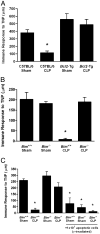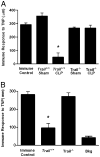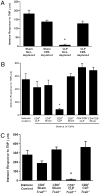Sepsis-induced apoptosis leads to active suppression of delayed-type hypersensitivity by CD8+ regulatory T cells through a TRAIL-dependent mechanism
- PMID: 20483771
- PMCID: PMC2887093
- DOI: 10.4049/jimmunol.0904054
Sepsis-induced apoptosis leads to active suppression of delayed-type hypersensitivity by CD8+ regulatory T cells through a TRAIL-dependent mechanism
Abstract
Patients who survive severe sepsis often display severely compromised immune function. One hallmark of such immune suppression in septic patients is an impaired delayed-type hypersensitivity (DTH) response, manifested by a loss of skin testing to recall Ags. Because sepsis induces significant apoptosis in lymphoid and myeloid cells, and apoptotic cells are themselves tolerogenic, we tested the hypothesis that suppression of DTH is mediated by tolerogenic properties of the apoptotic cells generated during sepsis. Mice subjected to cecal ligation and puncture demonstrated a loss of DTH for the 7 d following cecal ligation and puncture; however, the immune response returned to normal by day 10. Blocking sepsis-induced apoptosis via Bcl-2 overexpression or Bim deficiency prevented the loss of DTH. Importantly, injection of apoptotic cells into Bim-/- mice prevented an effective DTH response, thereby suggesting a causal link between apoptotic cells and immune suppression. Surprisingly, when TRAIL null mice were examined, we found that these animals had significant apoptosis but retained their DTH responses. Further studies revealed that apoptotic cells generated during sepsis induced a CD8+ regulatory T cell that suppressed DTH by TRAIL production. These results establish a link between apoptotic cells and immune suppression during sepsis and suggest TRAIL may be a viable therapeutic target for boosting the adaptive immune response following sepsis.
Conflict of interest statement
The authors have no financial conflicts of interest.
Figures





References
-
- Angus DC, Linde-Zwirble WT, Lidicker J, Clermont G, Carcillo J, Pinsky MR. Epidemiology of severe sepsis in the United States: analysis of incidence, outcome, and associated costs of care. Crit Care Med. 2001;29:1303–1310. - PubMed
-
- Murphy SL. Deaths: final data for 1998. Natl Vital Stat Rep. 2000;48:1–105. - PubMed
-
- Munford RS, Pugin J. Normal responses to injury prevent systemic inflammation and can be immunosuppressive. Am J Respir Crit Care Med. 2001;163:316–321. - PubMed
-
- Oberholzer A, Oberholzer C, Moldawer LL. Sepsis syndromes: understanding the role of innate and acquired immunity. Shock. 2001;16:83–96. - PubMed
Publication types
MeSH terms
Substances
Grants and funding
- GM44118/GM/NIGMS NIH HHS/United States
- R01 EY006765/EY/NEI NIH HHS/United States
- R56 AI077565/AI/NIAID NIH HHS/United States
- R01 GM055194/GM/NIGMS NIH HHS/United States
- GM55194/GM/NIGMS NIH HHS/United States
- R37 GM044118/GM/NIGMS NIH HHS/United States
- R01 GM044118/GM/NIGMS NIH HHS/United States
- F32 EY006765/EY/NEI NIH HHS/United States
- P30 EY002687/EY/NEI NIH HHS/United States
- R01 EY015570/EY/NEI NIH HHS/United States
- EY015570/EY/NEI NIH HHS/United States
- EY06765/EY/NEI NIH HHS/United States
- EY02687/EY/NEI NIH HHS/United States
- AI077565/AI/NIAID NIH HHS/United States
LinkOut - more resources
Full Text Sources
Medical
Molecular Biology Databases
Research Materials

